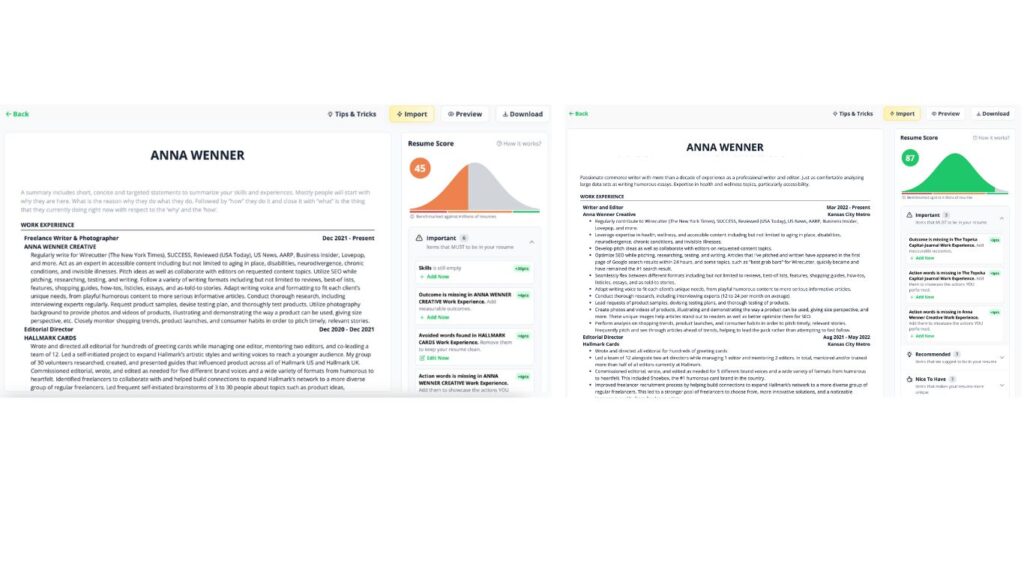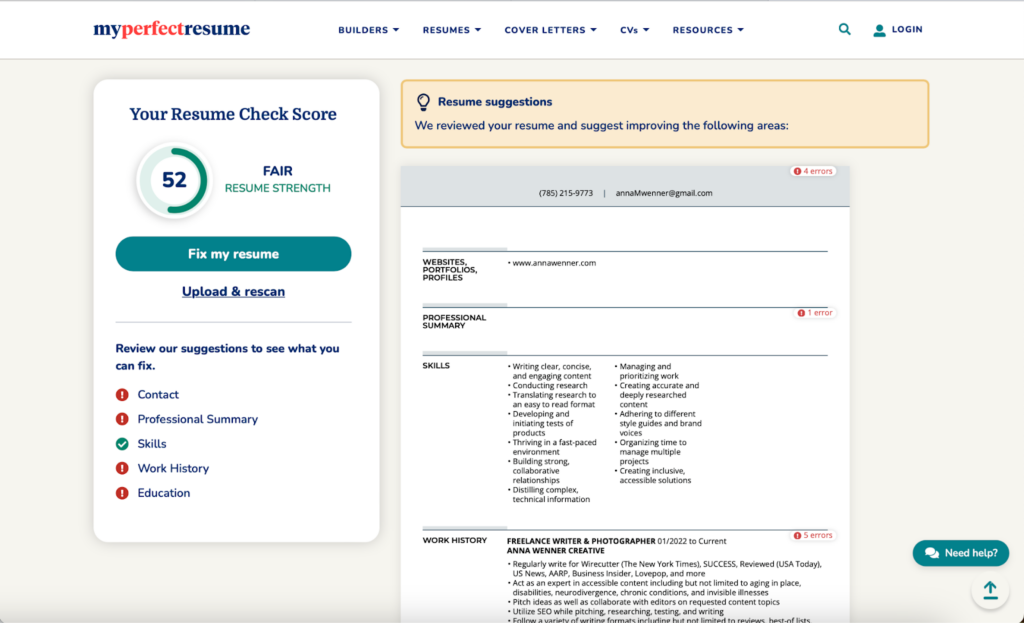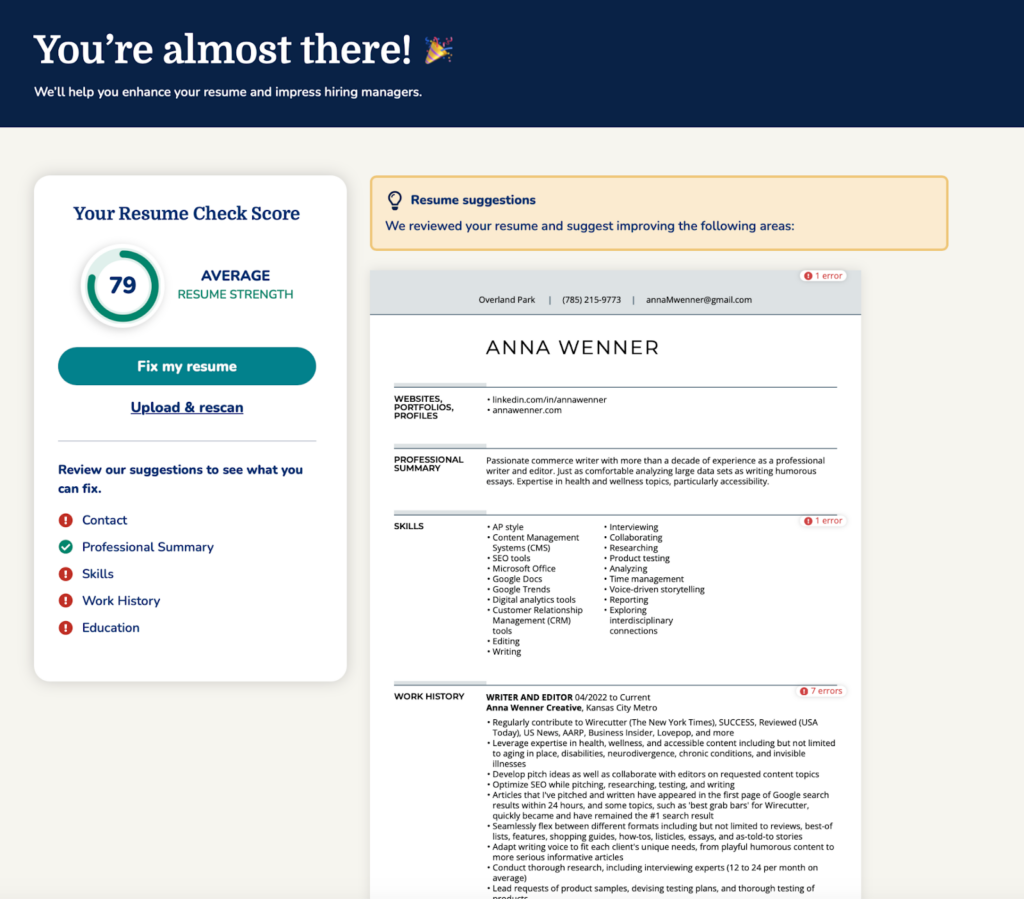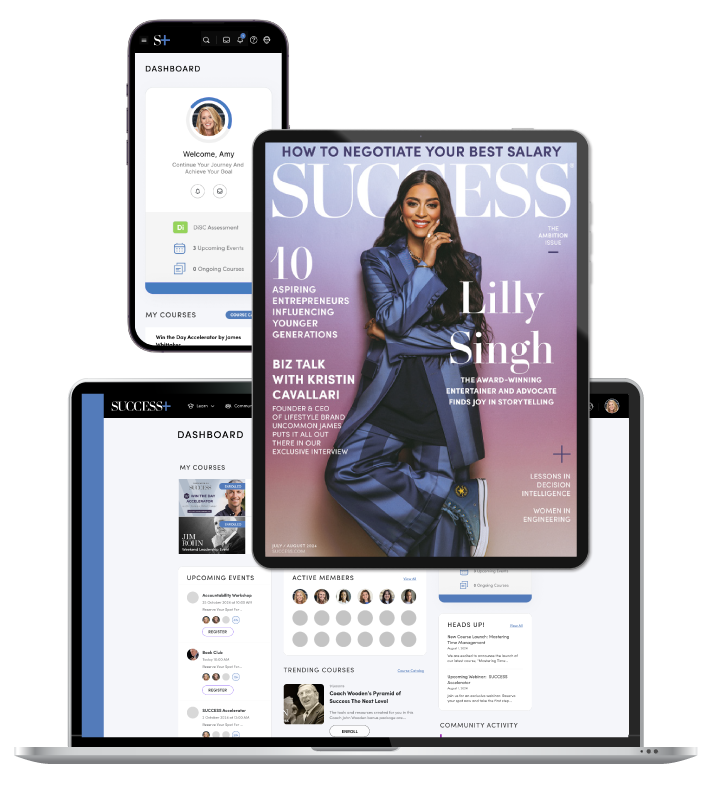Artificial intelligence (AI) is everywhere, including the hiring process. From applicants using tools like ChatGPT to practice interviews to recruiters using applicant tracking systems (ATS), AI has become a component that requires deft navigation skills within these realms. Optimizing your resume is one way to make sure your application has the best chance of being considered, but how do you know if it’s truly at its best?
Well, who better to check than AI itself?
I dug into the world of AI optimization tools aimed at job seekers to discover how they can help applicants, the best options available and the things to watch out for while using them.
What AI job application checkers can do
Like most technology, not all AI optimization tools are created equal. Consider standard word processors like Microsoft Word, Pages and Google Docs. Each one does the same basic thing, yet they vary in how they’re used, what their capabilities are and how accurate certain features like grammar assistance might be. This is just as true of AI-powered optimization tools.
There are tons of options for using AI to check the optimization of your job application materials, but the ones we tested for this article were: Weekday, NodeFlair, ResumeGo, MyPerfectResume, SkillSyncer, Enhancv, ResyMatch and Jobscan.
While not universal, the most common basic functions that AI-optimization tools offer job seekers include:
- Resume and cover letter scoring and optimization tips: Helps to identify formatting, keywords, phrasing and more to ensure your materials are as professional looking and sounding as they can be. When scoring, many provide a number out of 100 to show how optimized your materials are at a glance.
- Resume match rating: Compares your resume to others of a similar job title (for instance, an “editor”) or compares it directly to the job description of the job you’re applying for. They can also offer suggestions for translating your experience to be more applicable to the job posting.
- Resume building: Provides format templates, transfers data from existing resumes and offers other easy ways to switch your resume over to an ATS-friendly layout.

Does a good score on an AI checker really make or break your application?
Let’s be clear here: No AI-powered tool can guarantee that you’ll get hired somewhere. They can’t even guarantee a human will see your application. While it’s true that seven in 10 companies plan to use some form of AI within the hiring process by the end of 2025, that doesn’t mean that a machine is making the final call.
Career coach Rebecca Henninger notes that “ATS, or applicant tracking systems, are really no more than digital filing cabinets. They are the systems HR and recruiting professionals use to manage the hiring process, from initial intake through interview stages and even for extending offers.”
Russell Ayles, founder of Etisk, conducted some research of his own into the topic and found that the large majority of recruiters did not have their applicant pile scored or pre-selected by an ATS. When resumes failed to make it to a human recruiter, it was more often to do with yes or no questions (which are a type of “killer question” or “knockout question”) than anything related to an optimized resume. For instance, knockout questions such as whether you’re authorized to work in a particular location or whether you meet a basic job qualification had much more impact on an application’s success than keyword choice.
How much do AI checkers cost?
The cost of using these AI-optimization tools varies drastically. Some, such as NodeFlair, advertise being entirely free. Others, such as Jobscan, offer a few free scans per month, but then add a paywall for more.
Below is an example of how much some of these AI-powered application optimization tools cost per month at the time of this writing. Though some offer free or discounted rates at the start or for a few scans each month, these rates are what you can expect to pay if you plan to use the tools regularly.
Weekday: Free
NodeFlair: Free
ResumeGo: Free to one-time $10 payment
MyPerfectResume: $8 to $24 per month
SkillSyncer: Free or $12 to $15 per month
Enhancv: $13 to $25 per month
ResyMatch (Cultivated Culture): $14 to $28 per month
Jobscan: Free to $50 per month
The secret behind the scoring
While the scoring and rating systems can be an engaging way to see where your resume currently stands, you shouldn’t rely on them to tell the whole story. If a company is making its money primarily by helping applicants optimize, reformat or otherwise revise their resume, it’s in the company’s best interest to say that a resume needs a lot of help.
To test out these sites, I used my own resume and compared it across some of the most popular AI checkers. First, I tested an old resume that I knew wasn’t optimized well for AI, and my optimization scores ranged widely from 39% to 75%.
Next, I used NodeFlair’s free resume builder to revise my resume to be fully updated and optimized according to the tips each website had provided.

Image: Before and after image of my resume pre-optimization and post-optimization using NodeFlair’s resume builder. (Contact information has been removed at top.)
From there, I did a final scan with each site using the newly optimized resume. With some sites, such as NodeFlair, these changes made a big difference in my score. I was able to go from 45 to 87 out of 100. However, this didn’t necessarily translate to a better job match or a stronger resume optimization score for all of the sites. Some of the scores remained the same despite my changes, while others rose but still had trouble reading key parts of my resume (such as my contact information).
That said, on the sites with paywalls, there was a rather suspicious trend. Even with the changes, I couldn’t get my resume into the “good” area for any of them. For example, MyPerfectResume initially scored me at 52 and gave the new resume a 79, but it classified my optimized resume as merely “average resume strength,” since their “good” score is anything above 80.


Image: Score on MyPerfectResume before and after making AI-optimization changes.
While it’s absolutely possible that it was user error that kept my resume out of the “good” sections, it was still a good reminder not to rely on the optimization checkers exclusively.
According to Henninger, “Tools like Jobscan can be used, just like ChatGPT, to help candidates understand what the required and desired qualifications for a role are, but the scoring feature and all the other ‘hacks’ do more harm than good for jobseekers.”
How to use AI-powered tools to optimize your resume
After testing out all of the tools mentioned above, here are a few tips that I recommend when using any of them:
- If you’re using the scores or rating systems, check your resume across two different sites to compare.
- The personalized suggestions for improvement are significantly more useful than the rating itself. For instance, on my resume, every site agreed I should have a summary, so I knew that was a change that I needed to make.
- Resume builders are fine to use, but be cautious of paywalls if you don’t plan to subscribe. Many won’t let you download or edit your new resume without paying, which will mean a whole lot of wasted work.
- Just because a site claims something is an ATS-friendly format doesn’t mean it’s true. Several times sites created columns, added pictures, used unusual fonts and created other elements that can be hard for an ATS to process.
- Remember that at the end of the day, an AI-optimized resume is good, but a resume that is ugly, boring or hard to read for human eyes will cause problems of its own. AI isn’t hiring you—recruiters are. Make sure that your application works for both.
Photo courtesy of Perfect Wave/Shutterstock










